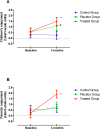Effects of music therapy as an adjunct to chest physiotherapy in children with cystic fibrosis: A randomized controlled trial
- PMID: 33125399
- PMCID: PMC7598495
- DOI: 10.1371/journal.pone.0241334
Effects of music therapy as an adjunct to chest physiotherapy in children with cystic fibrosis: A randomized controlled trial
Abstract
Airway clearance therapy (ACT) is considered an important approach to improve airway clearance in children with cystic fibrosis (CF). Daily ACT administration requires substantial commitments of time and energy that complicate ACT and reduce its benefits. It is crucial to establish ACT as a positive routine. Music therapy (MT) is an aspect of integrative strategies to ameliorate the psycho-emotional consequences of chronic diseases, and a MT intervention could help children with CF between the ages of 2 and 17 develop a positive response. The aim of this randomized controlled trial was to evaluate the effects of specifically composed and recorded instrumental music as an adjunct to ACT. We compared the use of specifically composed music (Treated Group, TG), music that the patient liked (Placebo Group, PG), and no music (Control Group, CG) during the usual ACT routine in children with CF aged from 2 to 17. The primary outcomes, i.e., enjoyment and perception of time, were evaluated via validated questionnaires. The secondary outcome, i.e., efficiency, was evaluated in terms of avoided healthcare resources. Enjoyment increased after the use of the specifically composed music (children +0.9 units/parents +1.7 units; p<0.05) compared to enjoyment with no music (0 units) and familiar music (+0.5 units). Perception of time was 11.1 min (±3.9) less than the actual time in the TG (p<0.05), 3.9 min (±4.2) more than the actual time in the PG and unchanged in the CG. The potential cost saving related to respiratory exacerbations was €6,704.87, while the cost increased to €33,524.35 in the CG and to €13,409.74 in the PG. In conclusion, the specifically composed, played and compiled instrumental recorded music is an effective adjunct to ACT to establish a positive response and is an efficient option in terms of avoided costs. Trial registered as ISRCTN11161411. ISRCTN registry (www.isrctn.com).
Conflict of interest statement
The authors have declared that no competing interests exist.
Figures



References
Publication types
MeSH terms
Associated data
LinkOut - more resources
Full Text Sources
Medical
Miscellaneous

